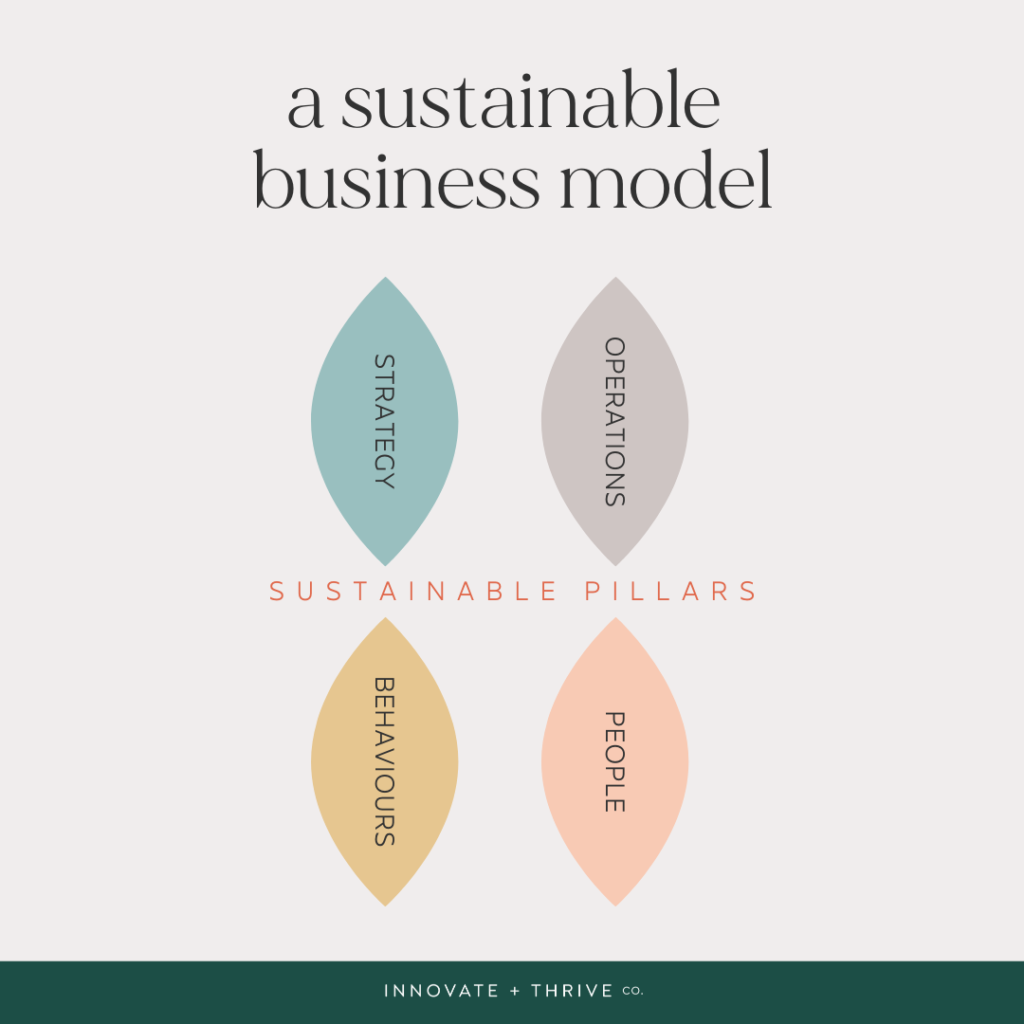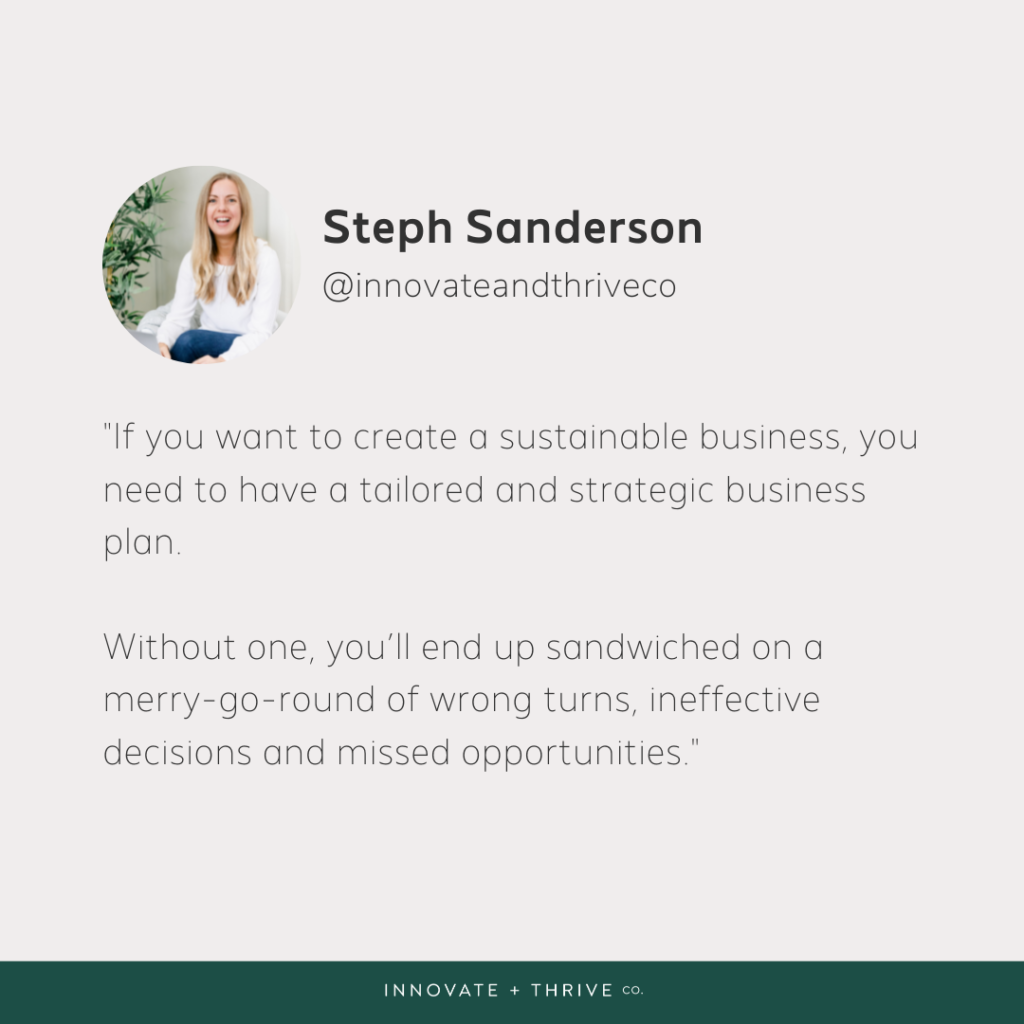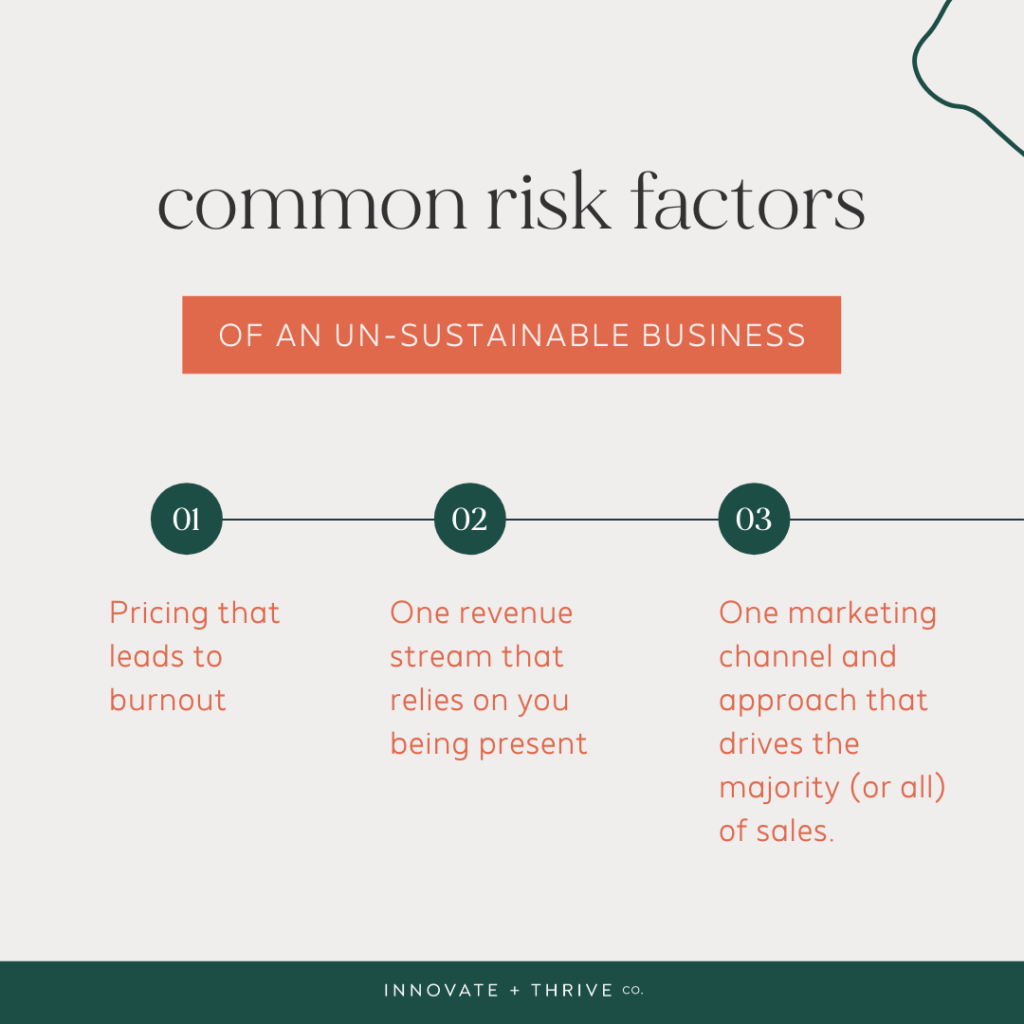

Sustainable Business | strategies to de-risk your business
It’s a mind boggling fact that around 20% of new businesses fail in the first year, and 60% within the first three years. And no, this isn’t due to some cruel twist of fate; more often than not, it comes down to them not having a sufficiently sustainable business to last the test of time.
A sustainable business is one with low risk business practices that achieve the desired financial and reputational outcomes while supporting and promoting the physical and mental health of the people in the business.
A sustainable business considers clients, services, prices and marketing in a holistic way. It also prioritises the needs of the business owner and team members, while mitigating the many risks that can lead to anxiety and failure.
In order for a business to succeed, there has to be a market need for it. This need must be held up by the right product positioning and cost, effective marketing, people and processes and, of course, a strategic business model.
Sustainable business can also be used to describe ethically conscious businesses; however, here I will focus purely on the ways that you can create a low-risk business that will thrive far into the future.
What is a sustainable business?
A sustainable business focuses on activities that drive success while lowering the many risks that crop up on a daily basis.
As the name suggests, a sustainable business is all about the long term game. It isn’t a ‘quick fix’ approach to running a business, and it requires a lot of planning and insight to get it right. For that reason, it isn’t for everyone.
Which is fine – except, without a sustainable business you are immediately setting yourself up for the risk of feast or famine finances, a disappearing audience, becoming irrelevant to your ideal clients and the burnout of you and your team. And that doesn’t sound all that great, does it?
What is a sustainable model?
So, what actually is a sustainable business model? A sustainable model has all of the typical pillars you would expect from a business plan: strategy, operations, behaviours and people. However, we approach them in a slightly different way.


First thing’s first: take a step back. Right back, so you can see your entire business in all of its glory. Because if you’re using a sustainable business model, then you need to consider your business as a whole.
Typically, desired revenue sits at the heart of a business plan. Here, that isn’t the only consideration. In addition, you need to look at the journey and longevity of your business; is it simple and robust? Would your business continue if you were pulled away, or decided to take a break? Does EVERYTHING rest on your shoulders?
We can then approach each pillar of your sustainable business model (using my BOPS framework).
- STRATEGY – What do you offer? Who do you offer it to and how? How much does it cost?
- OPERATIONS – What processes and technology do you need to put in place to facilitate the above strategy? Can you use it to manage clients and coordinate the team? If not, how do you plan to do so?
- BEHAVIOURS – Look at your values; do they drive your business? What is your mission and purpose? Are you actively building a culture? Is this all reflected in your strategy and operations?
- PEOPLE – Who do you need in your business in order to effectively bring your strategy to life? How will you ensure that they share your vision for the business?
As you can see, the pillars link together and support each other; no single pillar is more important than the other. It’s what makes a sustainable business model so powerful… No stone is left unturned!
How do you create a sustainable business model?
If you want to create a sustainable business, you need to have a tailored and strategic business plan. Without one, you’ll end up sandwiched on a merry-go-round of wrong turns, ineffective decisions and missed opportunities.


Whether you want to map this out on a project management board, through pen to paper or carved on the inside of a cave wall, the important thing is to pull up your socks and get cracking. The below is the process that I take my clients through whenever I design a new sustainable business model:
Business summary: include a description of your business, services and/or products, the finer details of roles you will outsource or resource, any business premises and whether you will work full or part-time.
Market research: Explore any of the opportunities you’ve identified and your epic idea for a product or service, backed by your competitor pricing structures, gaps in the market and trends you’ve observed and any lessons learned from your previous reporting period. Your drivers: what are your values, vision and mission?
Products and services: Here you should go into the detail on each individual product or service. This is the time to calculate cost, retail price and profit margin.
Operations: What processes do you need to map, which systems will you use and where will your facilities be located (and at what cost)?
People: Your strategic business plan will likely have gaps that need to be filled in terms of delivery. Consider who you will bring onboard to support this, and whether they will be employed or outsourced. You’ll need role descriptions and possibly performance management guidelines.
Financial forecasting: This is SO much more than daydreaming about your first 10k month. The reality of financial forecasting isn’t as black and white, so be sure to note fixed costs and overheads, variable costs, projected income and projected profit.
Marketing plan: I cannot stress this enough… Do not just focus on one channel for your marketing! Where are your clients showing up (both on and offline)? That’s where you need to be.
Goals: Look at the year ahead and set SMART goals that both keep you on track and encourage you to strive for more (while enjoying the journey!).
SWOT analysis: Take an objective look at the strengths, weaknesses, opportunities and threats that exist within and around your planned business. Look for ways to turn weaknesses into strengths, and threats into opportunities.
Need a gentle nudge in the right direction? Get my FREE business plan checklist below, and have a read of my blog Strategic Business Plan | The What, Why and How of Planning.
What is a sustainable business strategy?
A sustainable business strategy is paramount in plotting and achieving your long term goals, mitigating risk and paving the way for your ongoing growth.
It has all of the typical features of a standard business strategy (which I’ll dig into in my next blog, ‘10 steps to create a business strategy’), but it throws the magnifying glass on some very specific elements in order to ensure the plan is sustainable and primed for longevity.
Your services
This is a crucial place to mitigate risk because your services present a hefty load of potential pitfalls.
They can be a double edged sword – while a service that relies on you being present can be high value – helping you hit your revenue goals – they also rely on you being available all of the time. What if you’re sick? Or, you know, fancy a holiday? Immediately you lose your income. So, if you rely solely on these 1-1 services, you could easily find yourself in a sticky financial situation when life doesn’t go to plan.
Plus, these services can be exhausting. They’re intense and require a lot of brain power. And if it’s a one off service, it also means continuously searching for new clients: cue diminished time and the threat of burnout.
Avoid these issues by diversifying your revenue streams. At a minimum, you should have three: project, recurring/retained and passive. Take a look at each stream and decide how much % of your desired revenue you want it to represent. Once you have these figures in mind, you can adjust your marketing and business goals.
RELATED: INNOVATE. THRIVE. OTHER PODCAST – LET’S TALK ABOUT… SCALING A BUSINESS
Your pricing
The big ‘P’! Pricing is probably the thing that I am asked about the most as a business consultant. Why? Because it’s an absolute minefield!
You need to ensure that your pricing reflects your service, experience, expertise and the value of transformation that you bring to your clients. Which isn’t easy – but it’s necessary.
Without the right pricing under your belt, you will quickly find yourself in a position where you are actually losing money or, on the other side of the fence, alienating your ideal clients. Both are far from ideal and could easily jeopardise your business success.
Instead, choose a pricing structure that is financially viable and can be delivered with the capacity you have in your team. Let’s explore that a little further.
Sustainable business pricing
Pricing can make or break a business – and yet we find it incredibly difficult to get it right for many reasons. Often these reasons are personal and deeply ingrained; negative narratives, money trauma and confidence issues can all have an enormous impact on the way we approach money and business. But, how can we find a way to leave those inner narratives at the door?
I believe that it is paramount that we learn how to separate ourselves from our business finances while also taking the time to unpick WHY we find it hard to ‘charge our business worth’. Whilst working with clients on pricing, I ask them to prepare with a series of money mindset journaling prompts (which is followed by an in-depth, evidence based pricing model build) to help get to grips with the money stories that they’ve been telling themselves, and how they can rewrite them.
Remember: your pricing isn’t about you… It’s about your services and your clients. So, why don’t we make that super practical?
There are several pricing methodologies out there; all of which appeal to different businesses and types of business owners. The main types are:
- Cost-plus pricing
- Value-based pricing
- Competition oriented pricing
I have also created my own Innovate + Thrive. Co Service Pricing Strategy which you can find out more about here. Ultimately, the aim is to turn your pricing into something tangible – so, whether that’s through competitor pricing, costs, values, differentiation or market research, find a format that works for you.
Particularly for sustainable pricing, it’s critical that you focus on building a turnover that covers costs, goals, holidays, desired working hours and, of course, a contingency. Desperate to work three days a week? Build it into your pricing. Need to take time off for childcare? Build it into your pricing. Keen to grow a team and delegate tasks so that you can increase your client base sustainably? You guessed it – build it into your pricing.
RELATED: HOW MUCH SHOULD I CHARGE FOR MY SERVICES?
Sustainability and entrepreneur burnout
Entrepreneurial burnout has almost become a buzz phrase; and not without justification. There is a major correlation between running a sustainable business and avoiding burnout. Afterall, if we disregard our working patterns, our inherent need to rest, our need for additional support and our overall capacity, we will inevitably find ourselves waving ‘hello’ to burnout.


Ever feel like you’re drowning in the curse of the business owner brain? Nodding along? Me too. It’s that niggly inability to switch off… EVER. And when we can’t switch off, sometimes it feels easier to simply keep working. Despite the fact that overworking will only ever inch you closer and closer to burnout.
Listen – we’ve all been there! That’s okay. The important thing is to have the foresight to move out of that space. To acknowledge that, maybe, we’ve pushed ourselves a tad too hard and to wipe the slate clean and start again. We have to look after our physical and mental health – as well as that of our team – if we want our businesses to have longevity. Let’s face it: you can have the most incredible, award-winning and earth shattering service in the world… Without the people to deliver it, it may as well be a pipedream.
But there’s more: we can’t forget marketing. It can take up massive chunks of time; and rightly so! Marketing is what keeps our business in business. However, ask yourself: are you channeling your energy into the most sustainable marketing activities?
Spend some time making a note of WHERE you are marketing your business, how long you are spending on these platforms and what you are getting in return. While you’re at it, consider how these platforms make you feel. Do they build up your energy or drain it? Do you feel excited by them or do you dread logging on?
Yes, marketing matters – but it has to be worth it. Identify whether or not you are getting an adequate return on your time, energy and money investment.
RELATED: INNOVATE. THRIVE. OTHER PODCAST – LET’S TALK ABOUT… OVERWORKING.
Risky business strategy examples
We’ve already identified some of the key risks that a sustainable business can help you avoid – but what are the riskiest business strategies?


Where do I begin?! The list is LONG, but I’ve drilled it down into (what I believe!) are the three core strategies to avoid at all costs if you want a sustainable business.
- Pricing that leads to burnout.
- One revenue stream that relies on you being present 24-7.
- One marketing channel and/or type of marketing driving the majority (or all) of sales
Each of these strategies may feel like obvious things to avoid, but I see them played out every single day. Instead, I encourage you to:
- Structure your pricing so that it allows you to live the personal and professional life that you NEED.
- Diversify your revenue streams into a minimum of three: retainer/recurring, project and passive.
- Spread your marketing efforts and ensure you are using marketing platforms that you OWN (aka, do not rely on Instagram!) and more than one approach (aka, don’t rely on launches!).
Essentially, your business should support your physical and mental health, give you the space to live a life outside of work and be built in a way that leads to a steady and regular stream of income (at the level you want!). Not too shabby, right?
De-risking your business
You’re probably wondering how you can de-risk your business right now. And while I always encourage you to design a sustainable business model that is specific to you and you alone, there are some handy tips that you can get started on straight away.
Start by readdressing your pricing strategy. Is it in line with your goals, costs, competitors, value to client and team wellbeing? If not… Why? Also be sure to check that you are saving for a contingency fund in case of any low-income months or unexpected expenses.
Next, check in on your services. Make sure that you have at least three revenue streams. Then, think about what your ideal client needs and find different ways that you can offer it to them. For example:
- Pre-recorded workshops
- Courses
- Programmes
- Digital downloads
- Support subscriptions
- Membership
- Retained services
- Intensive sessions
Finally, take a look at your marketing channels and consider long form, outreach, PR and slower burn activities that will keep working when you’re not.
Not only will this widen the ways that money can come into your business, but it will also speak to different clients at various stages of their business journey. More boxes ticked, more clients banging on your door. It’s a yes from me!


Steph Sanderson is a business design consultant who helps service-based businesses to accelerate their growth in a sustainable way through pricing, customer experience, process planning, systems and strategic planning. She has over 15 years experience in the field, working as a business manager, global Change Manager and Implementation Specialist. Find out more.
